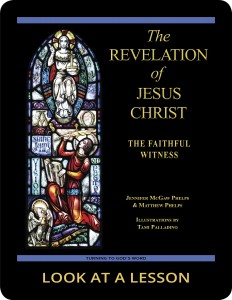left behind
 When the liturgical year begins to wind down, we encounter a passage in which Jesus informs us that at the end some people will be taken and some will be left. This passage in the Gospel According to Luke 17:34–35 (NABRE) and similar passages have caused a great deal of discussion about the end times and who will be left. The notion of the rapture in which some people are taken and some are left behind derives from this passage and from the First Letter to the Thessalonians 4:17 (NABRE), which in English translations uses similar vocabulary to that found in the Gospel passage.
When the liturgical year begins to wind down, we encounter a passage in which Jesus informs us that at the end some people will be taken and some will be left. This passage in the Gospel According to Luke 17:34–35 (NABRE) and similar passages have caused a great deal of discussion about the end times and who will be left. The notion of the rapture in which some people are taken and some are left behind derives from this passage and from the First Letter to the Thessalonians 4:17 (NABRE), which in English translations uses similar vocabulary to that found in the Gospel passage.
The Gospel According to Luke uses the words παραλαμβάνω (paralambano), which means “to take or receive,” and ἀποτίθημι (apotithemi), which means “to put away or keep back.” The connotation of this passage essentially is one of some people being invited and some not.
Paul’s version usually is translated using the same words as the Gospel account—left and taken—but the underlying meaning and emphasis is considerably different. περιλείπομαι (perileiptomai) means “to remain over or to survive” and ἁρπάζω (harpazo) means “to seize, to capture, or to rape.” This violent imagery, often connected to life and death, gives the First Letter to the Thessalonians a decidedly different connotation.
Because the connotations of these two passages are somewhat at odds, they raise a number of questions. Will the end times be peaceful enough that one not invited could even sleep through them, as in the Gospel account? Or instead, will some people be violently captured and taken up by God, as described by Paul? In either case, what is clear from both versions is that whenever the time comes, not all will be called into union with God.
related topics: apocalypse; judgment; parousia
you also may like our study of the book of Revelation
 The Revelation of Jesus Christ: The Faithful Witness, a 23-lesson Catholic Bible study with an imprimatur, examines ways in which our traditional Christian view of heaven is built on Hebrew apocalyptic visions recorded in the Old Testament. This recently revised study includes maps and additional commentary and takes a close look at the role of the prophets in present-day Christianity. Illustrations by Tami Palladino depict the often-misunderstood images in the book of Revelation. Click on the book’s cover to view a sample lesson.
The Revelation of Jesus Christ: The Faithful Witness, a 23-lesson Catholic Bible study with an imprimatur, examines ways in which our traditional Christian view of heaven is built on Hebrew apocalyptic visions recorded in the Old Testament. This recently revised study includes maps and additional commentary and takes a close look at the role of the prophets in present-day Christianity. Illustrations by Tami Palladino depict the often-misunderstood images in the book of Revelation. Click on the book’s cover to view a sample lesson.
 Click on the picture of the statue of Moses with horns (above) to learn more about Lost in Translation. A new entry is archived each Monday. Contact us to receive Lost in Translation by email every week. You may use any of the contact links on our website to ask Matthew a question.
Click on the picture of the statue of Moses with horns (above) to learn more about Lost in Translation. A new entry is archived each Monday. Contact us to receive Lost in Translation by email every week. You may use any of the contact links on our website to ask Matthew a question.

Leave a Reply
You must be logged in to post a comment.